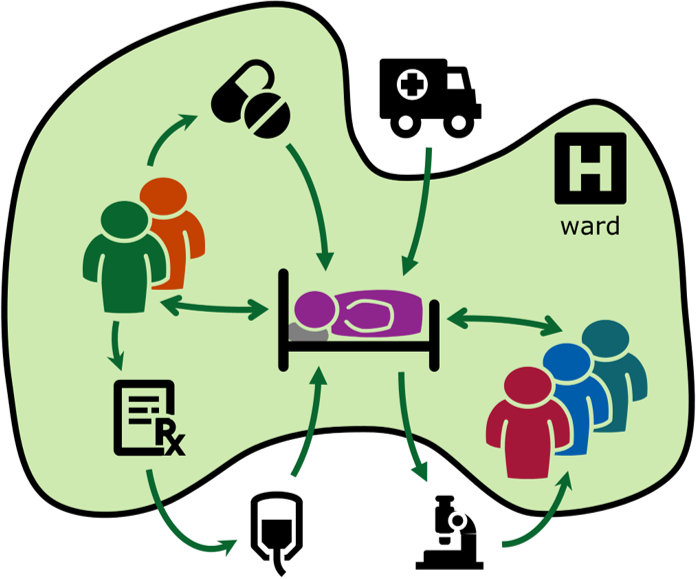In order to understand a systems approach it is useful to first understand systems, or even systems of systems. The use of the term has become more prominent of late as the world around us, or at least our understanding (or design) of it, becomes more complex. The term has multiple origins across many disciplines and as a result the Oxford English Dictionary reveals a rich source of definitions, the most relevant being:
system, n.
- A group or set of related or associated things perceived or thought of as a unity or complex whole
- A set of persons working together as parts of an interconnecting network
- An organized scheme or plan of action, esp. one of a complex or comprehensive kind.
A system may be described at multiple levels of detail; for example, it may describe the ‘whole’ — the Healthcare System; a part of the whole — a hospital; a smaller part — the emergency care system; an even smaller part — an x-ray imaging system; or smaller again — the x-ray image handling system. In all cases, a system can be seen to be part of a larger system or to contain all or parts of other systems. These Systems of Systems (SoS) are characterised by a set of systems or system elements that interact to provide a unique capability that none of the constituent systems can accomplish on its own1.
Systems have defined boundaries, are designed to fulfil specific functions and typically have have inputs, which are the resources or information they need from their environment, and outputs, which are produced by the system’s processes. The description of a system provides the opportunity to describe not only the elements or people involved, but also the presence and nature of the interfaces between them. It is these interfaces which determine the expected and emergent behaviours of the system.
A systems approach is a holistic and interdisciplinary way of understanding and solving complex problems. It views the world as a collection of interconnected and interdependent elements or people, and emphasises the relationships and interactions between them.
A systems approach aims to determine the system design and implementation that delivers the best service. It has the potential to drive greater efficiency and a better understanding of threats and opportunities present when shaping the delivery of health and care services. A systems approach builds on the principles of systems thinking, systems engineering, design thinking and social science to bring together four key and complementary perspectives:
- People — understanding of interactions among people, at the personal, group and organisational levels, and other elements of a system in order to improve overall system performance;
- Systems — addressing complex and uncertain real world problems, involving highly interconnected technical and social elements that typically produce emergent properties and behaviour;
- Design — focusing on improvement by identifying the right problem to solve, creating a range of possible solutions and refining the best of these to deliver appropriate outcomes;
- Risk — managing risk, based on the timely identification of threats and opportunities in the system, assessment of their associated risks and management of necessary change.
This approach, first presented in Engineering Better Care, provides practical guidance and resources to facilitate its application to health and care improvement. It comprises a set of guiding questions — drawn from the people, systems, design and risk perspectives — accompanied by a set of activities, tools and definitions, and a simple model of the improvement process. Together these support all stages of the improvement process, from problem definition to solution delivery, ensuring that the right problem is solved in the right way.
A systems approach is useful for improvers of all levels of experience and applicable to challenges of all levels of complexity. It has the potential to transform health and care, with benefits for patients, service users, and providers. It is also compatible with and can add value to any existing improvement models and initiatives.
1 Systems and software engineering — System of systems (SoS) considerations in life cycle stages of a system. International Organization for Standardization, Geneva, Switzerland, 2019.
Feedback
We would welcome your feedback on this page:
Privacy policy. If your feedback comments warrant follow-up communication, we will send you an email using the details you have provided. Feedback comments are anonymized and then stored on our file server
Read more about how we use your personal data. Any e-mails that are sent or received are stored on our mail server for up to 24 months.



